Did you know that fire can threaten any home, big or small? The Government of British Columbia offers wildfire protection tips. These tips show how important it is to make your home fireproof.
Simple steps like installing smoke detectors or using fire-resistant materials can help. These actions can protect your home from fires.
Creating a fire safety plan is key to keeping your family safe. Regularly check fire safety tips and make smart safety habits. This can help protect your home from fires.
By covering all areas, including emergency gear and home construction, you can stay safe. This all-around approach is crucial in preventing fires.
Key Takeaways
- Fire can affect all types of households across the country.
- Smoke detectors and extinguishers are core fire safety tips.
- Fire-resistant materials offer greater resilience in wildfire-prone regions.
- Prevention steps and plans lower home fire risks significantly.
- Staying informed on local fire conditions supports smart decisions.
Understanding Fire Risks at Home
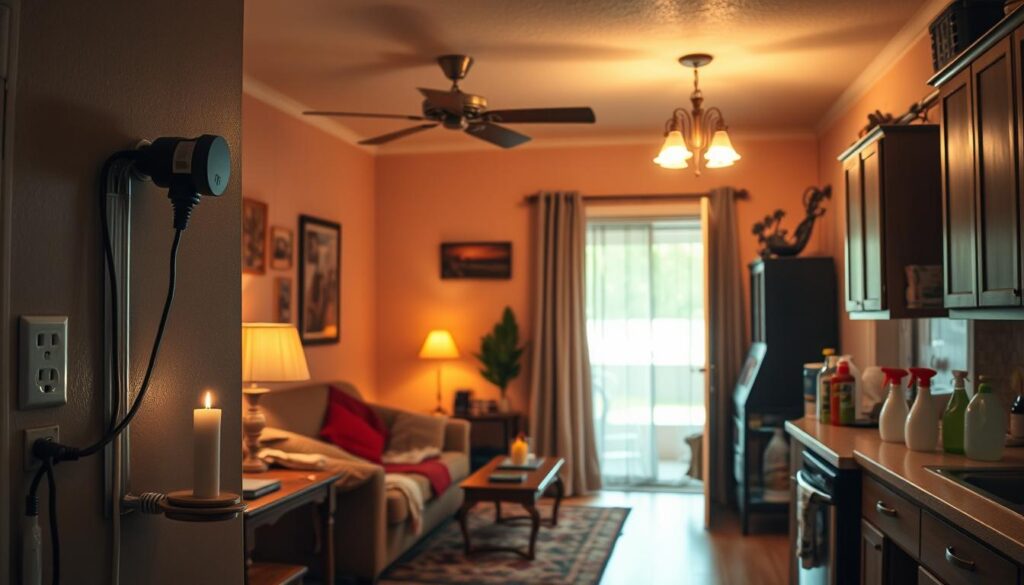
Many families in the United States face unexpected losses when fires happen. Small flames can quickly turn into big problems. Clogged gutters or branches near the roof can cause a crisis.
A 2021 report from the National Fire Protection Association shows that cooking, heating equipment, and electrical issues are common causes. To reduce these risks, it’s important to have fire protection strategies.
Creating a fire safety checklist helps find cluttered areas and faulty wiring. Trimming branches near chimneys or stovepipes stops embers from spreading. Keeping firewood away from your home also reduces the risk of fires.
Using fireproofing products makes your home more resistant to fires. Installing spark arresters with small mesh openings stops sparks from drifting. Keeping your home’s Immediate Zone clean also helps prevent fires.
Regularly checking your home for fire hazards is key. This protects your loved ones and property from fires.
Key Home Fire Risks and Tips
| Common Hazard | Prevention Tip |
|---|---|
| Unattended Cooking | Stay in the kitchen and keep flammable items away from burners |
| Electrical Overloads | Check wiring yearly and update faulty outlets |
| Clogged Gutters | Clear leaves and debris to prevent fire spread |
| Overgrown Landscaping | Space shrubs at least 15 feet apart to reduce fuel loading |
How to Fireproof Your Home: Key Steps for Maximum Protection
Keeping your home safe from fires starts with knowing where dangers lie. Look for bad wiring and clutter in every room. Smoke alarms in bedrooms and hallways can alert you to fires early.
Having fire extinguishers in easy spots, like the garage or kitchen, helps stop small fires before they grow. Looking into new upgrades can also save money and help improve your home’s safety. A good fire escape plan is key, so everyone knows where to go and what to do in an emergency.
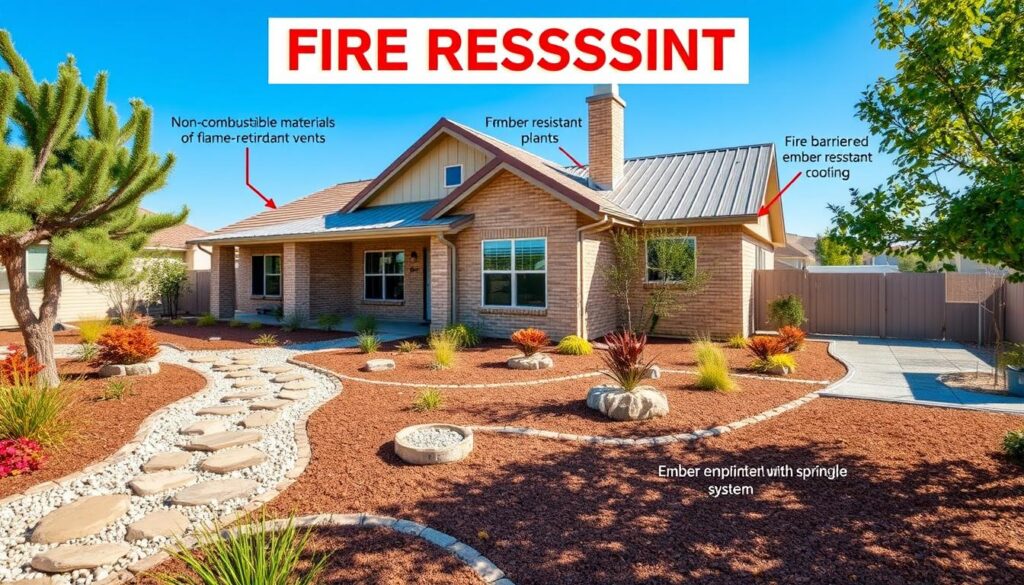
Inspecting Potential Hazards in Each Room
Look out for frayed cords and overloaded sockets, as they can cause fires. Keep things that can catch fire away from heat sources. Even small changes can help protect your belongings from fire.
Choosing Fire-Resistant Materials for Remodeling
Choosing materials like metal over wood can make your home safer. Using steel frames with fire-resistant insulation adds extra protection. These steps help build a home that can withstand fires.
| Area | Common Hazard | Preventive Action |
|---|---|---|
| Kitchen | Grease fires | Keep extinguisher nearby |
| Garage | Chemical spills | Store chemicals safely |
The Role of Smoke Alarms and Carbon Monoxide Detectors
Creating a safer home begins with devices that spot dangers early. These tools help make a house safe from forest fires. They work well with fire-safe building methods to protect your home.
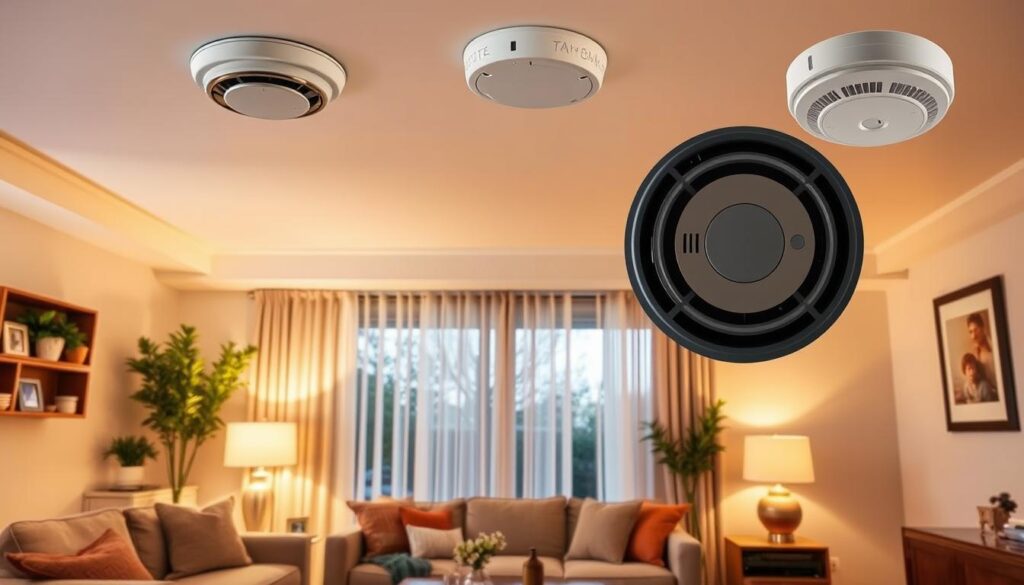
Homes without working alarms are nearly four times more likely to face fatal fires. The National Fire Protection Association says three out of five fire deaths happen where alarms are missing or broken. Adding carbon monoxide detectors helps since CO gas is odorless and tasteless.
Proper Installation Guidelines
Place alarms on every level and near sleeping areas for quick alerts. Experts say test devices monthly to make sure they work. Many choose alarms that sound off throughout the house if one goes off.
Maintenance Schedules
Change batteries twice a year. Replace alarms every 10 years to avoid malfunctions. Keeping sensors clean is also key to avoid failures during emergencies. These steps help prepare for unexpected dangers.
| Maintenance Task | Frequency | Impact |
|---|---|---|
| Test Alarms | Monthly | Reduces fire-related death by up to 50% |
| Replace Batteries | Twice a Year | Ensures consistent power and quick alerts |
| Replace Detectors | Every 10 Years | Maintains reliable performance |
Fire-Resistant Insulation and Roofing Materials
Choosing strong products is key for a fire-safe home. Mineral wool insulation, made of noncombustible fibers, slows down fire spread better than usual materials. It adds a protective layer to walls and attics, helping to build a fire-resistant house.
Fiberglass-based asphalt shingles cover 80% of American roofs. Yet, many look for better options to add extra protection.
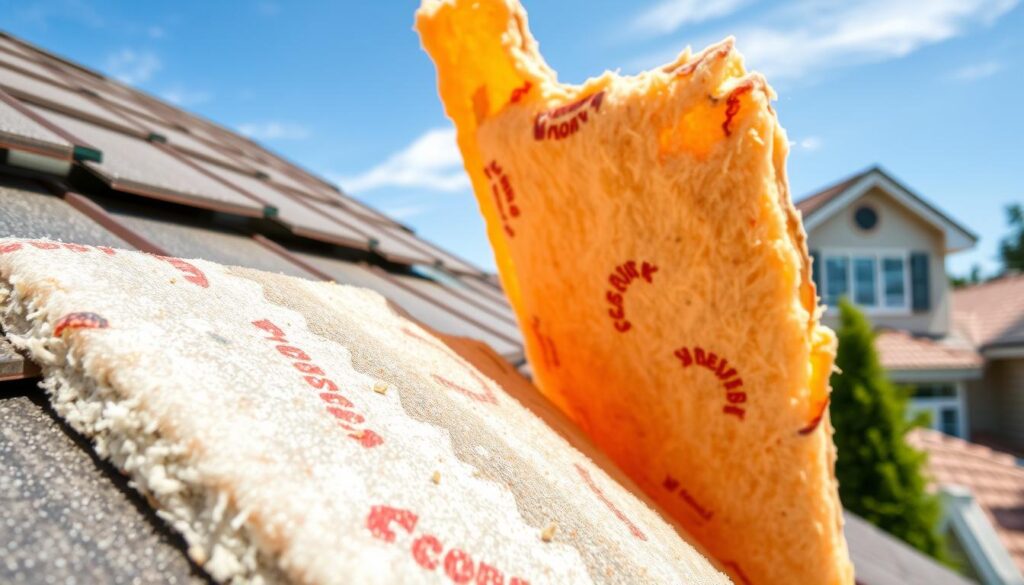
Metal roofing, with the right underlayment, often gets a Class A fire rating and lasts 30 to 50 years. Clay tiles are durable and heat-resistant, making a house fireproof while insulating well. Premium slate or synthetic shingles from top brands offer various styles, helping to build a fireproof house.
Investing in these upgrades can bring long-lasting fire protection benefits.
| Material | Fire Rating | Market Share | Lifespan | Brand Example |
|---|---|---|---|---|
| Asphalt Shingles | Class A | 80% | Up to 30 Years | CertainTeed’s Highland Slate |
| EcoStar’s Majestic Slate | Class C | — | Up to 50 Years | Eco-Friendly Design |
| Metal Roofing | Class A with Proper Underlayment | Growing | 30–50 Years | Various Manufacturers |
| Clay Tiles | Noncombustible | — | Long Lifespan | Multiple Brands |
| Slate | Highly Fire Resistant | — | 75+ Years | Premium S1 Grade |
Creating a Fire Escape Plan and Fire Safety Checklist
Fires can happen anytime. Having a plan for getting out and staying safe is key. Sadly, one in three homes don’t have a clear plan. This can make it hard to act fast when seconds count.
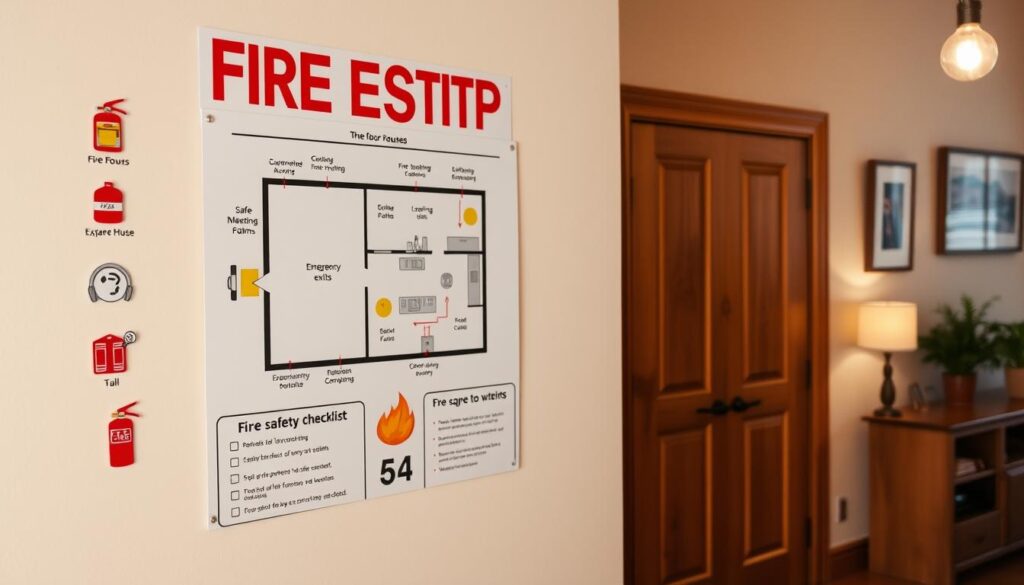
Smoke detectors can cut fire death risks in half. Alarms that talk to each other make homes safer by 40%. Even a fireproof house needs a good plan. This is crucial when every second counts.
Mapping All Possible Exits
Explore each floor and mark all doors and windows. Make sure exits are clear of stuff. This makes it safer and saves time in emergencies.
Practicing Escape Drills with Family Members
Drills help everyone know what to do in a fire. Families who practice twice a year are 75% more ready. A fireproof home helps, but drills make everyone calm and quick.
- Check corridor lights for visibility
- Keep ladders near upper-floor windows
- Test alarms monthly for optimal performance
| Task | Frequency | Reason |
|---|---|---|
| Inspect exits | Monthly | Ensures clear pathways |
| Review drills | Twice a year | Refines group readiness |
| Assess alarms | Every season | Preserves vital warning times |
By following these steps and building a fireproof home, you’re ready for anything. This brings peace of mind to your family.
The Importance of Fire Extinguishers and Sprinkler Systems
Small fires can start from cooking mistakes or electrical issues. They can quickly turn a normal evening into a disaster. A good extinguisher can stop these fires from getting bigger. This gives homeowners time to call for help.
This action is key in any fire safe building plan. It’s closely linked to fireproofing home efforts. These focus on acting fast and efficiently when a fire starts.
Sprinkler systems use sensors and valves to react quickly. They send water right to the fire, reducing damage to walls, ceilings, and belongings. It’s important to check the water pressure and valve function regularly. This ensures the system works well and meets fire proof construction standards.
Experts say this makes a home safer. It’s part of a fireproof house design that offers the best protection.

Studies show that an extinguisher can stop a small fire before it gets dangerous. Sprinklers do the same, making any fireproof construction plan better. Both options provide a safety layer for families, apartments, and big houses. They help prevent fires from getting out of control.
Many stores now sell affordable extinguishers and parts. This makes it easier for people with different budgets to get them.
Key Equipment and Maintenance Tips
- Position fire extinguishers in easily accessible spots.
- Inspect water-based sprinkler lines monthly for leaks.
- Test extinguisher pressure gauges and replace expired units.
| System | Function | Key Maintenance |
|---|---|---|
| Fire Extinguisher | Quells small flames quickly | Check pressure gauge monthly |
| Sprinkler System | Automated response to fire | Inspect valves and water flow regularly |
Outdoor Fire Safety and Landscaping Tips
Open areas around a home can let embers in. But, careful yard work can help. Remove dry branches and clean gutters to protect your home.
Homes with metal gutters are 80% safer from fires. Keeping grass short and clearing clutter within 30 feet also helps.

These steps make homes more fire-resistant. Yard work and fire-safe building create a strong defense against flames. Studies show homes without debris outside are much safer from fires.
Maintaining a Defensible Space
Dead leaves and long limbs can fuel fires. Fire-safe homes have a clear area around them. This saved 90% of homes in the 2003 Cedar Fire.
Selecting Fire-Resistant Plants
Choosing the right plants can help protect your home. Succulents, lavender, and sage keep moisture, slowing fires. This makes your home stronger against heat and erosion.
| Zone | Distance from Home | Purpose | Recommended Plants |
|---|---|---|---|
| Zone 0 | 0–5 ft | Block ember contact | Noncombustible groundcover |
| Zone 1 | 5–30 ft | Reduce fire spread | Low-growing succulents, sage |
| Zone 2 | 30–100 ft | Slow ground fire | Widely spaced shrubs, lavender |
Securing Your Home Against Wildfires
Wildfire seasons can be tough on roofs and siding. Sparks can travel up to half a mile. So, a well-planned perimeter is often the first defense. California requires a 100-foot safe zone, while wooded areas need a 50-foot buffer.
Using fireproof materials is key to a wildfire-proof home. These materials can withstand intense heat. A good design should also include covered vents and dual-pane windows with tempered glass.
Keeping siding at least six inches off the ground is also important. These steps help make homes more heat resistant. Programs like Firewise USA® and FEMA’s BRIC help communities adapt to fire risks.
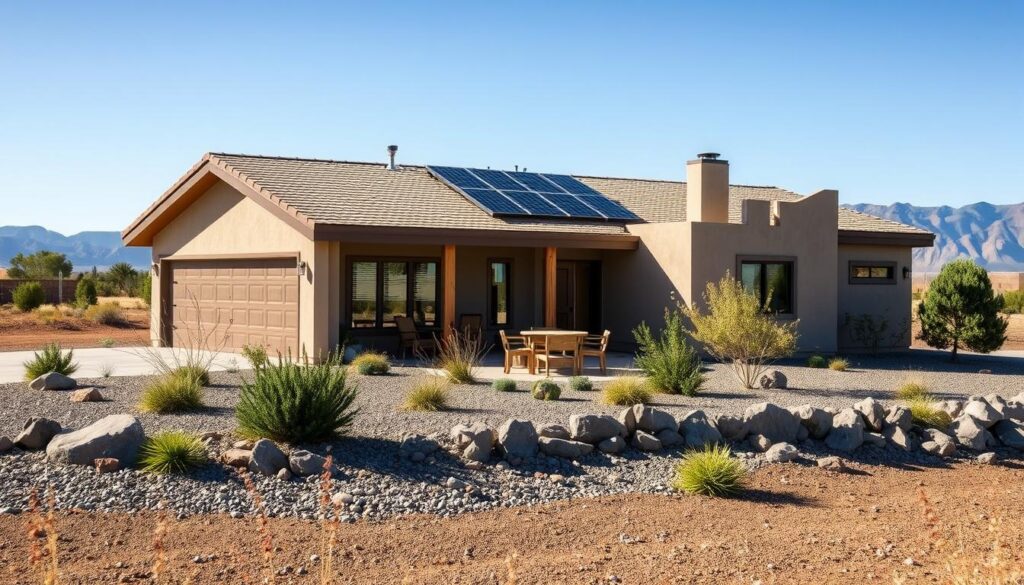
Defensible Strategies and Material Choices
| Focus | Implementation | Outcome |
|---|---|---|
| Perimeter Clearance | Maintain 100 ft buffer | Reduces ember impact |
| Roof and Gutter Protection | Install noncombustible covers | Prevents debris ignition |
| Window Upgrades | Use tempered dual-pane glass | Guards interiors from heat |
| Vents and Siding | Cover vents and raise siding | Limits entry points for embers |
Fireproofing Techniques for Building a New Home
Many people ask if it’s possible to build a fireproof house. Fire-resistant designs can reduce damage and give more time to evacuate safely. Fireproof technology makes homes strong without losing comfort or style.
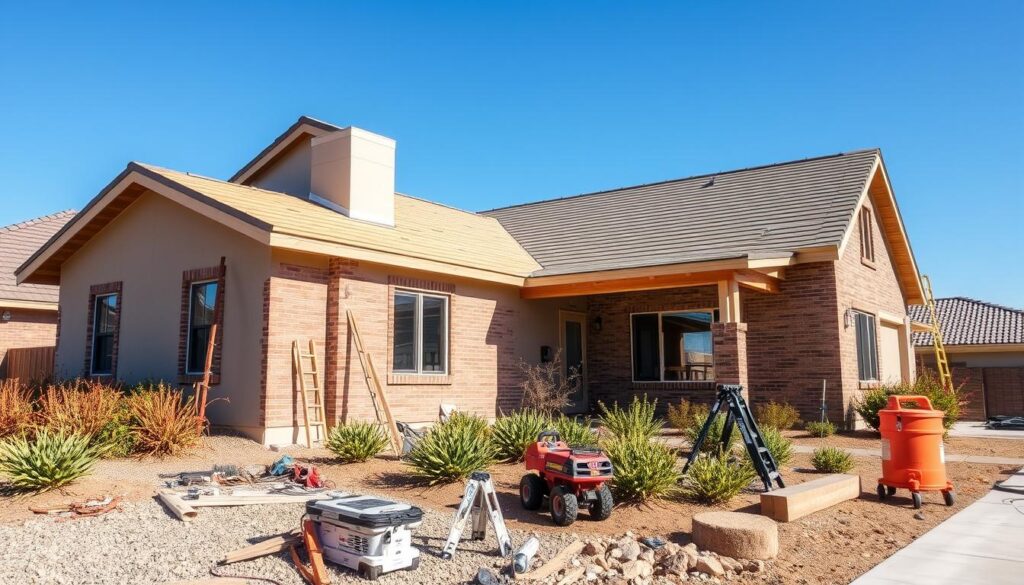
Advanced Fire-Resistant Materials
Materials like brick or stone can slow fires and save homes. Some walls can hold flames for sixty minutes, helping people escape. Insulated Concrete Forms can last hours, adding extra safety against heat.
Modern Construction Methods
Experts suggest using fireproof construction, like steel framing and non-combustible siding. This method lowers the risk of damage in extreme conditions. New treatments for wood also reduce the chance of it catching fire.
| Material/Method | Fire Rating | Cost Impact | Key Benefit |
|---|---|---|---|
| Brick or Stone | Class A | Moderate | Top-tier fire resistance |
| Insulated Concrete Forms | Up to 4 hours | 1%–4% above standard | Extended containment time |
| Steel Framing | Varies by coating | Higher initial | Reduced combustion risk |
| Fire-Retardant Wood | Rated approx. 20-60 mins | Low to moderate | Slows flame spread |
Essential Fire Safety Measures for Rental Properties
Fire is a danger to all homes, including apartments and big complexes. Rental places need careful planning to lower risks. Smoke alarms in each unit are key, as they can spot fires early and save lives.
The Government of British Columbia offers guides to protect homes near forests. These include keeping grass short and removing dry leaves.
Building with fire-resistant materials makes homes safer. Using top-quality materials can lessen damage and protect people inside. Landlords can make properties safer by using non-combustible siding.
In hot areas, metal or tile roofs are better. They make buildings more durable against fire.
Staying Proactive with Safety
Regular checks keep rental places safe and up to code. Making sure exits are clear helps people get out fast. Adding enclosed under-decking stops embers from getting in.
Building with fire resistance gives peace of mind. It also meets insurance requirements.

- Test smoke alarms monthly
- Monitor fire extinguishers
- Post detailed evacuation maps
| Action | Frequency | Key Benefit |
|---|---|---|
| Check Alarms | Monthly | Timely Detection |
| Inspect Exits | Yearly | Swift Evacuation |
| Review Siding | Seasonally | Reduced Fire Spread |
Common Mistakes Homeowners Make
Some people forget important tasks when they focus on fire safety. Even small mistakes can cause big problems and put people at risk. In the U.S., 27% of fires happen at home, showing the need for constant fire protection.
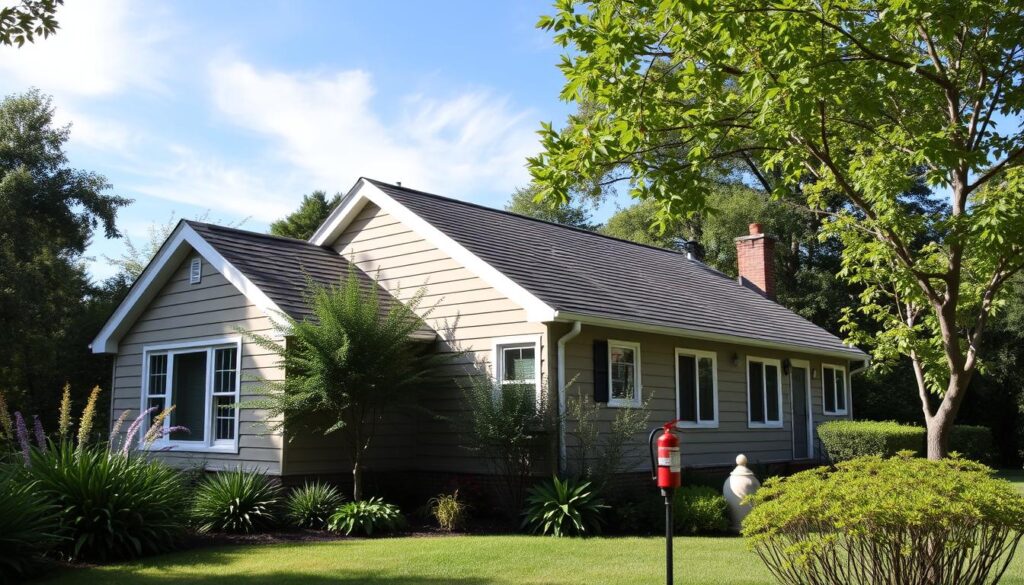
Knowing what makes a house fire-resistant is key. Staying alert, scheduling checks, and following expert advice can save you time and money.
Neglecting Routine Inspections
Not checking wiring or ignoring smoke alarm updates can weaken your home’s fire defense. Older homes are more at risk of electrical fires. They need regular checks to stay safe. Faulty wiring or broken detectors are common causes of house fires.
Using the Wrong Extinguishing Methods
Using water on a grease fire or the wrong extinguisher can make things worse. It’s important to choose the right method for each fire to prevent more damage.
| Mistake | Why It’s Risky |
|---|---|
| Ignoring Smoke Alarm Maintenance | Raises risk of undetected fires |
| Dousing Grease Fires with Water | Spreads flames, causing greater harm |
| Delaying Wiring Inspections | Increases chances of electrical sparks |
Budget-Friendly Ways to Upgrade Fire Protection
Nearly 354,000 house fires hit the United States yearly, the National Fire Protection Association (NFPA) says. A small budget can lead to big upgrades in home safety. Simple actions, like upgrading door sweeps or moving flammable stuff, can lower fire damage risks.
“The presence of smoke detectors can reduce the risk of dying in a home fire by 50%,” fire safety experts report.
Effective Low-Cost Upgrades
Small changes can make a big difference in fire safety, no matter your income. Replacing weather stripping with fire-resistant types keeps embers out. Using gravel or stone around the house foundation also lowers fire risks.
Coating wood siding with special paint is another cost-effective step. It aligns with making your house fire resistant. These changes save money and improve safety over time.
Choosing fireproof materials in stages is key for those on a budget. Moving wood piles away from walls and using non-combustible mulch are smart choices. Each small step adds up to a safer home.
Doing small projects over time makes a fireproof house affordable. This approach, backed by home safety data, includes using fire-retardant paints and keeping flammable items away. With patience, each upgrade enhances fire protection without breaking the bank.
Conclusion
Fire proofing house strategies are always changing. The roof is a big risk during wildfires. Cleaning debris monthly helps stop embers from igniting hidden spots.
A 30-foot defensible space around the house also helps. It protects against fast-moving flames. Plus, exterior wall coverings with a fire-resistance rating of at least one hour are important.
Fireproofing houses includes enclosing foundations and installing external sprinklers. Homeowners should choose designs with multi-pane windows and fireproof shutters. Clearly marked street signs and addresses help emergency services get there faster.
Securing Future Plans
Fire resistant architecture keeps up with new challenges every season. Families should make sure roads and driveways are at least 16 feet wide. This allows fire trucks to get through safely.
Fuel breaks, like spaced vegetation and trimmed branches, also help. Keeping a prepared toolset, including a tall ladder and a sturdy rake, is crucial for last-minute defense.
In states like California, wildfires are a growing threat. But with careful design and maintenance, families can feel safer. Regular inspections and flexible solutions add layers of safety for years to come.

